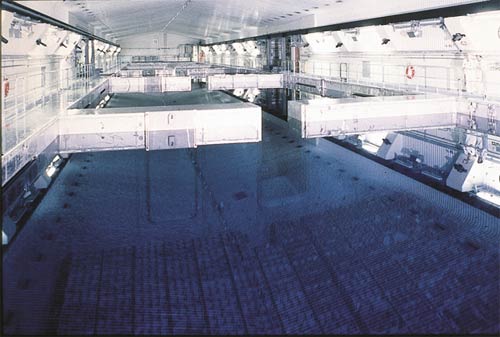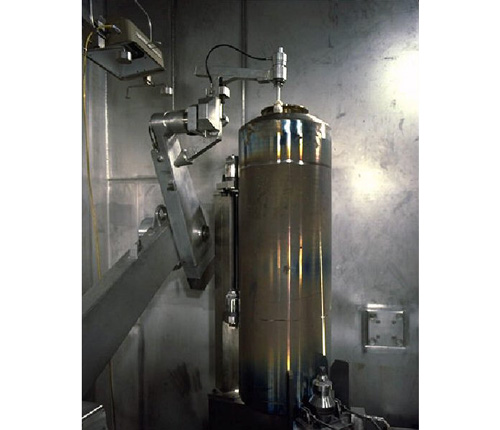A temporary solution

Sweden: Interim storage of spent fuel
Sweden does not reprocess its spent fuel. Since 1985, spent fuel from Swedish power plants is collected and stored in pools in a rock cavern excavated 30 m below ground. The uranium storage capacity of these pools is to be increased to 8,000 tons. Currently, 4,000 tons have been placed in storage. The fuel assemblies are visible underwater in the foreground. Design studies for a final repository in the granite 500 m underground are underway.
© SKB
Interim storage is a temporary solution that plays a central role in the management of the most highly radioactive materials: spent reactor fuel and, in France, vitrified waste resulting from reprocessing such fuel. Storing spent fuel and waste for several years allows heat release and radioactivity to subside. In the case of spent reactor fuel, this decrease facilitates reprocessing operations.
Interim storage also features in the final management phase. Products are stored not only to allow them to cool, but also as an interim solution pending definition of the final destination for vitrified reprocessing waste, which will probably be underground disposal in deep-lying geological layers. Storing waste for longer will enable the necessary final repository facilities to be smaller. Interim storage is planned for periods of several decades. To this end, in France, the most radioactive waste is currently stored at facilities in Marcoule and especially La Hague.
There are storage periods at several stages during reprocessing. Recently-unloaded spent fuel is first stored in a pool close to the reactor, before being transported to La Hague, where it is stored in another pool in which it will be allowed to cool for several years pending reprocessing. Lastly, after separating out the uranium and plutonium, vitrified waste from the reprocessing operation is stored in ventilated shafts pending final disposal.
Non-reprocessed spent fuel continue to be stored in pools at La Hague, pending a decision on its fate.

France: Pre-storage inspection
This photo shows containers of vitrified waste undergoing checks before being placed in storage after exiting Vitrification shop R7 at the UP2 800 spent fuel processing facility in La Hague plant.
© AREVA/Sydney Jezequel
In a country such as the United States, which does not currently reprocess its spent fuel, waste has remained in storage in reactor pools or dry silos for more than 30 years in some cases. This radioactive waste was intended to be transferred to Yucca Mountain, a huge repository located deep under the Nevada desert. However, after many years of hesitation, this huge project was abandoned in 2010 by the Obama administration. This decision has sent the United States back to the drawing board regarding the management of this radioactive waste, which remains dispersed among the country’s power plants.
Sweden, which does not reprocess its fuel, has built the CLAB storage facility in Oskarshamn, featuring large interim storage pools 30 m underground. This facility will be used until a repository is built.
In France, intermediate-level waste must also be stored, only 36% of which has been conditioned, with the remainder awaiting recovery and processing. Some legacy waste must also be dealt with, for example waste from the earliest power stations using the graphite gas process, which is stored in Marcoule. The ongoing process of dismantling retired power plants also produces low-level long-lived waste, which is being held in interim storage pending definition of a final management strategy.
Other articles on the subject « Waste management »
Waste management status
Repositories already in operation for low-level waste Compared with other types of waste, the mas[...]
Other storage facilities
Interim waste storage according to their nature and origin Spent fuel and vitrified waste from Pr[...]
Vitrified waste Storage
Dry storage of vitrified waste Spent nuclear fuel assemblies are not the only materials removed f[...]
Spent fuel storage
Interim storage in pools and then dry locations In all countries, spent fuel management begins wi[...]
Management outside France
Overview of waste management strategies outside France Management of the least radioactive waste [...]
LILW-SL waste repository
Disposal of low and intermediate-level short-lived waste Low and intermediate-level short-lived w[...]
VLLW repository
An operational repository for very low-level waste The second category of waste for which a repos[...]
High level waste transportation
Moving highly radioactive materials The 10% of transport movements that concern high-level radioa[...]
Transport safety
Measures to ensure safe transport Nuclear materials may be highly radioactive. The goal is to pre[...]
Transport-related incidents
Incidents but no accidents… Have radioactive material transport operations caused any accid[...]